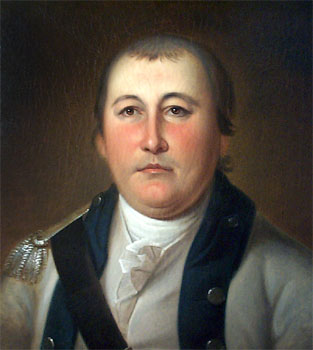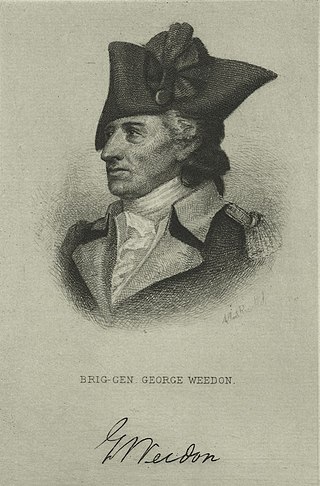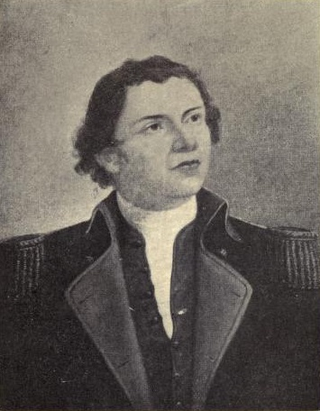
William Washington was a cavalry officer of the Continental Army during the American Revolutionary War, who held a final rank of brigadier general in the newly created United States after the war. Primarily known as a commander of light dragoons, he led mounted troops in a number of notable battles in the Carolinas during the campaigns of 1780 and 1781.

George Weedon (1734–1793) was an American soldier during the Revolutionary War from Fredericksburg, Colony of Virginia. He served as a brigadier general in the Continental Army and later in the Virginia militia. After the Revolutionary War ended he became an original member of the Society of the Cincinnati (Va.).

Hugh Mercer was a brigadier general in the Continental Army during the American Revolutionary War. He fought in the New York and New Jersey campaign and was mortally wounded at the Battle of Princeton.
The 3rd New Hampshire Regiment, also known as the 2nd Continental Regiment, was authorized on 22 May 1775, organized 1–8 June 1775, and adopted into the Continental Army on 14 June 1775, as the third of three regiments raised by the state of New Hampshire during the American Revolution. The enlistment dates for officers and rank and file soldiers extended to 23 April 1775, based on their response to the alarm for the Battles of Lexington and Concord.
The 6th Pennsylvania Regiment, first known as the 5th Pennsylvania Battalion, was a unit of the United States of America (U.S.) Army, raised December 9, 1775, at Philadelphia, Pennsylvania, for service with the Continental Army. The regiment would see action during the New York Campaign, Battle of Brandywine, Battle of Germantown, Battle of Monmouth, and Green Spring. The regiment was disbanded on January 1, 1783.
The 2d Virginia Regiment was authorized by the Virginia Convention, July 17, 1775, as a force of regular troops for the Commonwealth's defense. It consisted of seven companies, 476 privates and the usual regimental officers. William Woodford, of Caroline County, named colonel, along with Lieutenant Colonel Charles Scott and Major Alexander Spotswood were the regiment's initial field officers. Virginia had been divided into 16 military districts which took their names from the predominant county in the grouping; for instance, Prince William District included Fairfax and Loudoun Counties as well. Col. Gregory Smith 1777-78 Col Brent 1779
The 1st North Carolina Regiment of the Continental Army was raised on September 1, 1775, at Wilmington, North Carolina. In January 1776 the organization contained eight companies. Francis Nash was appointed colonel in April 1776. The regiment was present at the defense of Charleston in 1776. It transferred from the Southern Department to George Washington's main army in February 1777. At that time, Thomas Clark became colonel of the 1st Regiment. The regiment became part of General Francis Nash's North Carolina Brigade in July.
The 8th North Carolina Regiment was authorized on November 26, 1776, and assigned to the Southern Department of the Continental Army. The 8th North Carolina Regiment played a crucial role in the Defense of Philadelphia during the Philadelphia campaign. The unit saw action at the Battle of Brandywine, Battle of Germantown and the Battle of Monmouth during the Defense of Philadelphia of the American Revolution. A part of the continental army, the Regiment was commanded by Colonel James Armstrong. The regiment was disbanded on 1 June 1778 at Valley Forge, Pennsylvania.

The New Hampshire Line was a formation in the Continental Army. The term "New Hampshire Line" referred to the quota of numbered infantry regiments assigned to New Hampshire at various times by the Continental Congress. These, along with similar contingents from the other twelve states, formed the Continental Line. For the promotion of senior officials, this concept is particularly important. Officers of the Continental Army below the rank of brigadier general were ordinarily ineligible for promotion except in the line of their own state.

The North Carolina Line refers to North Carolina units within the Continental Army. The term "North Carolina Line" referred to the quota of infantry regiments assigned to North Carolina at various times by the Continental Congress. These, together with similar contingents from the other twelve states, formed the Continental Line. The concept was particularly important in relation to the promotion of commissioned officers. Officers of the Continental Army below the rank of brigadier general were ordinarily ineligible for promotion except in the line of their own state.

At the Battle of Brandywine on September 11, 1777 a colonial American army led by General George Washington fought a British-Hessian army commanded by General William Howe, 5th Viscount Howe. Washington drew up his troops in a defensive position behind Brandywine Creek. Howe sent Lieutenant General Wilhelm von Knyphausen's 5,000 troops to demonstrate against the American front at Chadd's Ford. Meanwhile, Lieutenant General Charles Cornwallis took 10,000 troops on a wide flank march that crossed the creek and got in the rear of the American right wing under Major General John Sullivan. The Americans changed front but Howe's attack broke through.
The 4th Continental Artillery Regiment, also known as Reign's Continental Artillery Regiment, was an American military unit during the American Revolutionary War. The regiment became part of the Continental Army on 10 June 1777 as Colonel Thomas Proctor's Continental Artillery Regiment. It was made up of eight artillery companies from eastern Pennsylvania. At the time of the regiment's formation, two companies were already in existence, one from as early as October 1775. One company served at Trenton in December 1776 where it performed well in action. In February 1777, Pennsylvania expanded its two-company battalion into an eight-company regiment. After officially joining the Continental Army, the regiment saw much fighting in the Philadelphia campaign in late 1777. Elements of Proctor's Regiment fought at Monmouth in June 1778 and joined the Sullivan Expedition in summer 1779.
Charles Harrison was born into the noted Harrison family of Virginia. His brother was a signer of the Declaration of Independence and his nephew William Henry Harrison later became president. At the beginning of the American Revolutionary War he became lieutenant in a company of artillery from Virginia. When the state expanded its small artillery battalion into a regiment in November 1776, Harrison was appointed commander with the rank of colonel. Initially named Harrison's Continental Artillery Regiment, the unit was renamed the 1st Continental Artillery Regiment in August 1779. He joined George Washington's main army in time to fight at Monmouth. In 1780 he led his gunners at Camden and the following year he commanded Nathanael Greene's artillery at Hobkirk's Hill.
Richard Parker was an American colonel who fought in the American Revolutionary War. Son of prominent Virginia jurist Richard Parker, Parker received an officer's commission in a Virginia regiment early in the conflict. He probably was present at Great Bridge and Norfolk. Promoted to major, he fought at Trenton in December 1776 and commanded the regiment at Second Trenton and Princeton in January 1777. At Brandywine in September 1777 he led a detachment of light infantry in delaying the British. The next month he fought at Germantown. Promoted to colonel at Valley Forge, he led a picked detachment at Monmouth in June 1778. In May 1779, George Washington ordered him back to Virginia to recruit a new regiment. After being sent south with a new unit of reinforcements for Charleston, South Carolina in late 1779, he died of wounds received at the Siege of Charleston in 1780.
The "German Battalion" was an infantry formation of the Continental Army during the American Revolutionary War. Authorized in May 1776 as an extra Continental regiment, the battaltion recruited ethnic Germans from Maryland and Pennsylvania.
The 1st Virginia State Regiment was a regiment of regular state troops from Virginia which fought during the American Revolutionary War.
The 2nd Virginia State Regiment was a regiment of regular state troops from Virginia which fought during the American Revolutionary War.




